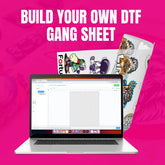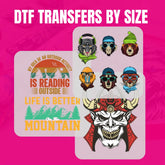How to Use DTF Transfer Sheets for High-Quality Prints?
In fabric printing, DTF transfer sheets have revolutionized the game. Using DTF transfers ready to press simplifies the procedure regardless of your size, business or level of hobbyist interest. Unlike conventional screen printing, DTF printing gives flexibility, durability, and economy, which calls for time-consuming preparations. Because it lets them print on various materials—from cotton and polyester to blends—many companies and individual artists choose this technique. Anyone may create professional-quality prints with a DTF machine free from costly manufacturing expenses.
How Do You Prepare DTF Transfer Sheets for Printing?
Choosing the correct design is the first step in using DTF transfer sheets. A high-quality photograph guarantees a sharp and detailed final print. For precise color reproduction, most DTF printers need files in CMYK format. Once the design is ready, DTF printing ink—which comprises CMYK and a white underbase—prints it onto a unique PET film. This underbase makes designs on dark-colored materials vivid as well.
After printing, sticky powder is added to the wet ink. This DTF heat transfer system guarantees proper ink bond attachment to the fabric. The powder has to be dispersed equally to prevent weak adherence or spots. Once coated, the transfer sheet is cured at the proper temperature in a heat press or curing oven. This stage is critical since it locks the ink into place, extending the lifetime of the artwork.
What Are the Differences Between DTF Printing and Other Methods?
DTF printing differs fundamentally from other widely used printing methods. Sublimation printing only works on light polyester textiles, thereby restricting customizing options, unlike DTF heat transfers. While great for mass orders, screen printing calls for expensive setup costs and long drying times. Although heat transfer vinyl (HTV) lets you customize as well, it requires cutting and layering, which makes executing intricate designs tough.
DTF transfers ready to press provide the best of both worlds—full-color prints free from too much layering. Unlike DTG (Direct-to-Garment) printing, which involves pre-treatment of fabric and works best on cotton, DTF printing equipment allows prints on almost any material without significant preparation. Custom clothing companies especially choose DTF transfer sheets because of their adaptability.
How Do You Apply DTF Transfers to Fabric?
The DTF sheet is prepared for pressing. Before application, the cloth must be dry and clean. The design is transferred for 15–20 seconds at 320°F (160°C) using a heat press. This procedure guarantees that the ink's binding to the substance is permanent.
DTF transfers ready for the press have one of the main benefits of simplicity of use. Unlike other techniques, DTF heat transfers require no weeding or extra preparation. Apply the transfer and let it cool before peeling. The kind of film will determine whether one uses a hot or warm peel technique. This penultimate stage decides the final print's durability and smoothness.
How Long Do DTF Prints Last?
DTF prints are pretty robust. Excellent DTF transfer sheets resist more than 50 washes without notable cracking or fading. DTF printing machine technology, together with adhesive powder, guarantees designs remain vivid. DTF heat transfers are better elastic than conventional heat transfer techniques, so they are perfect for often-washed clothing and activewear.
Conclusion: Why Should You Choose DTF Transfer Sheets?
Selecting DTF transfer sheets ensures practically any cloth will have excellent, long-lasting, adaptable prints. DTF transfers are ready to press and let companies and people quickly generate unique designs. The DTF printing machine approach offers professional results without complex settings and a flawless printing experience. If you're looking for premium DTF heat transfers, visit DTF Transfer Art to explore high-quality options.
- Blended fabrics for DTF
- bulk dtf transfers
- bulk printing
- Cotton for DTF
- Custom apparel
- custom apparel printing
- Custom clothing printing
- custom gangsheet
- Custom gangsheet DTF transfer sheets
- Custom gangsheet printing
- Custom Gangsheets
- custom heat transfers
- Custom iron patches
- custom prints
- decal transfer
- decal transfers
- Digital printing
- Direct-to-Film Transfer
- dtf business
- DTF gangsheet
- DTF Heat Press
- dtf print shop
- DTF printer supplier
- DTF Printing
- dtf transfer
- dtf transfer art
- dtf transfer film
- dtf transfer instructions
- dtf transfer paper
- DTF transfer paper suppliers
- dtf transfer printer
- dtf transfer sheets
- DTF transfer supplier
- DTF transfer wholesale
- dtf transfers
- dtf transfers near me
- dtf transfers ready to press
- dtf transfers wholesale
- DTF vs Screen Printing
- DTF vs Vinyl
- DTF vs. iron-on
- dtf wholesale
- gangsheet printing
- heat press printing
- Heat press settings
- Heat settings for DTF
- heat transfer decals
- heat transfer method
- heat transfer printing
- Heat transfers
- hoodie printing
- Hoodies
- hot peel DTF
- iron-on decals
- Leather DTF transfers
- Local print shops
- Mild detergent for DTF prints
- Nylon DTF transfer
- Peeling or cracking prevention
- Polyester for DTF
- premium DTF transfers
- print on demand
- Print shops near me
- Printed designs durability
- Printing companies
- Printing methods
- Quality printing
- reliable DTF transfer printer supplier
- Spandex DTF transfer
- sticker printing
- Stretch fabrics DTF
- t shirt printing
- T-shirts
- Textile printing
- Tote bags
- Transfer printing
- trustworthy DTF transfer supplier
- vinyl decals
- Washing care for DTF prints
- what is dtf transfer






